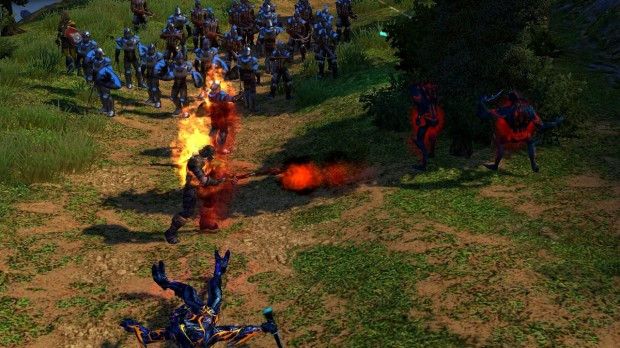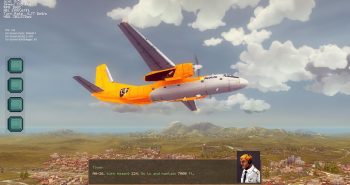Nordic Games and Dream Catcher Interactive have just released their latest expansion to Spellforce 2, named Spellforce 2: Faith in Destiny. Faith in Destiny was originally announced back in 2009 but, due to budget concerns as well as their wanting to avoid a May 15, 2012 release date that would coincide with Diablo III, wasn’t released until June 19 of this year. Spellforce 2: Faith in Destiny is, at heart, a role-playing real time strategy game, that is set four years after the last expansion. Faith in Destiny does not require the original game to play this expansion, but you will be completely lost as to where you are in this particular story, what the world is about, or even who your character is supposed to be.
Story:
Spellforce 2: Faith in Destiny is set four years after the Shaper’s defeat. You are a Shaikan who is traveling through Eo in search for answers to the troubling dreams that you are having and to investigate attacks on the local villages by a group of monsters called the Nameless.
If you understood any of that last paragraph, you are much better off then I am, and I played the game. The major issue with Spellforce 2: Faith in Destiny’s storyline is that the developers pretty much assumed that you played the original Spellforce 2 and its other expansion. Yet, they made Faith in Destiny a stand-alone game that did not require either game to play. I can understand why a developer did not want to require a consumer to have to locate and purchase another game from 2006 in order to play this expansion, but the player needs to be brought up to speed on the story, and not just dropped off in the world, assuming that we will pick up the pieces as we go along.
What ends up happening is that I am forced to accept things with the hope that I will learn more later, and that kept me from becoming enraptured with the story from the beginning. I found myself constantly asking questions as to what was a Shaikan, who was this traveling with me, and what are these portals that keep popping up. I am a huge fan of writing in video games, and feel that it does not get enough quality time nor does it get nearly enough of the budget for my tastes. However, the player must feel like he or she is at least following along with the plot, so that we may actually care about what people have to say. When a player is lost from the beginning, they have a tendency just to skip all of the dialogue, because ‘nothing has made sense prior to that conversation, why would that conversation make any sense now?’
Game Play:
The game play of Spellforce 2: Faith in Destiny survives critique so much better then the story did. The game play here is solid role-playing real time strategy game mechanics. The role-playing mechanics focuses solely on your hero characters. You get to create your own Shaikan, but can only select from male characters and only select from pre-selected heads. As your heroes level up, you get to give them abilities based on combat, magic, or Shaikan trees. You will also find gear in treasure chests or on enemies to help flesh out your heroes. The great thing about the gear is that is actually changes the looks of your heroes. This can lead to your heroes looking much more unique then other heroes that are out there, especially in multi player, but more on that later.
The real time strategy mechanics for Spellforce 2: Faith in Destiny is what makes this game at least a solid outing for Nordic Games. Let me get this out, I hate real time strategy games, I’m just no good at them and can’t stand all of the micro-management that is needed to be any good at them. Spellforce 2: Faith in Destiny is a game that is made for people like me. The developers made resource management extremely easy by using a user interface that was very intuitive. I loved being able to double click on a troop type, then clicking on a pull down menu to assign that troop a group number. I also loved how each group would have their abilities directly under their group number, so I could activate an ability from group 2 then one from group 4 with two simple clicks of a button.
Everything else about the real time strategy mechanics for Spellforce 2: Faith in Destiny you have seen before. Faith in Destiny uses three resources, instead of the typical two so you do have one more resource to stress about, but besides that, this is a typically solid real time strategy game through and through. When faced with such a lackluster story line, Spellforce 2: Faith in Destiny is mediocre at best and cannot compare to recent games such as Starcraft 2.
Spellforce 2: Faith in Destiny does have the typical multiplayer system in place, but with the exception of being played against an human opponent, there isn’t anything special here that you don’t see in the campaign. You have five factions to choose from, but again, with very little invested into the story; the only difference here is aesthetics. Multiplayer can support up to six players at one time, and does including a new game mode called Domination, where a player must capture and control certain points on the map.
Aesthetics:
Spellforce 2: Faith in Destiny has a unique look to it, but it is a look that is also outdated. Spellforce 2: Faith in Destiny looks more like Warcraft 3 then Starcraft 2, and that is probably because the game has been in development since 2009. Unique looks to a game when they are a design decision work for me. I have a much easier time forgiving the graphics for a game like The Bindings of Isaac when it is a deliberate decision to make the game look that way. However, for Spellforce 2: Faith in Destiny, the graphics just feel outdated. They’re not horrible by any means, just old looking.
Voice acting, on the other hand, was atrocious. I was doing ok with the acting, until a women came up to me in the main city with, what can only be described as the single worst attempt at a Scottish accent. At least, I think she was trying to pull off Scottish; it might have been something else. I’m not saying that we need Oscar winning actors for every game, but if your actor is going to try to pull of an accent, at least make sure that she is capable of doing so before you record it and put it in your game.
Final Thoughts:
At the end of it all, Spellforce 2: Faith in Destiny isn’t a bad game – it’s just not a great game either. It falls perfectly in the middle range that many games fall into – very playable for a while, but will soon be forgotten when the next bigger and better game comes out. What really kills Spellforce 2: Faith in Destiny to me was the lengthy developmental timeframe. If this game came out in 2008 or 2009, just a few years after the original, it would have been a very good game and a top-notch entry into the real time strategy genre for that time period. However, it’s 2012 and we have played Starcraft 2, and, while Starcraft 2 had it’s own issues, it clearly shows just how outdated Spellforce 2: Faith in Destiny really is. If you need a real time strategy game to tie you over until the next Starcraft 2 expansion comes out, you can do worse then Spellforce 2: Faith in Destiny. If not, then I would just wait it out until Heart of the Swarm hits the stores.






